Well, ok- it's not exactly the tropics, but it was a nice spot and you won't be able to tell in the final shots. The weather was slightly chilly and very breezy- not the best combination for putting a model in water. Brrrr! Today we were being hit from all directions with pitfalls- some were overcome, some weren't. But if you don't get out and try, then what does that say for your experience? Hand-carrying 300 pounds of gear a 1/4 mile along a hiking trail to a waterfall did suck, but it's all part of the process that is complicated location photography. Sure, we could go up there with a camera and a small flash, but it wouldn't look like the image I had in my head when it was done. The gear is just to meet the needs of the creative idea, not because it's fun to break people's backs. I'm glad to have some good help today, and what counts is having a common interest in creating unique ideas, putting them on paper (or web) and getting out and enjoying the day in the outdoors. Experimentation is the mother of all invention. [gallery link="file" columns="5"]
The New Diggs!
Our new studio location! It's a beautiful spot overlooking downtown Albuquerque right along Central Avenue. There are several rooms, a kitchen and a full bathroom including a shower! More pics to come once everything is set up, but for now here's a sneak peak. [gallery link="file"]
Hiring Assistants is an Interesting Job in Itself.
So I put an ad on Craigslist (and I wonder if "Craig" even owns that thing anymore or if AOL bought it by now- they buy everything that takes off) the other day stating that I'm looking to ad some new assistants. Just the usual info asking potential applicants to email over their age, availability, experience if any and interest in production photography- mainly fashion. I thought that maybe two guys at most would respond, you know, just weirdos who know nothing about cameras just looking to get around models. But boy was I wrong! That Craigslist is some powerful stuff! Within a day I had received on average 3 emails an hour from everyone from older experienced guys to 18 year olds with no experience just wanting a cool job. Some of these people were writing in from Cali and listed some pretty prestigious photographers that they had assisted for and said that they were moving to NM for better work. Say what! But what cracks me up is when you put down a job description that describes the need to be able to follow direction, and some people don't even follow the direction of sending what info I'm requesting. Some of my favorite (well, least favorite) emails included nothing more than how good of a photographer they are and a link to their photo website. That's great, if I were looking for a photographer! Others only mentioned that they had written several screen plays and I should call them to find out more. Ummm, ok. Also, I need to know their age because that tells me whether or not when the time comes to haul 400 lbs of lighting gear up to the top of a rocky hill if they are going to start describing their lower back pains and just stand there while I haul it all myself. It's a physically demanding job at times and I have to have people who can rock. Most of the applicants didn't include their age so I'm left wondering, "Are you 15 or 55?"
On the other hand, some of these folks are probably a little over-qualified for this gig. I never thought that there was such a thing, but when people are sending you resumes of years of working as an assistant and are looking for a new job that can provide for their families...well, this isn't it, man! I mean we don't do full-scale fashion shoots every day. I stay plenty busy; but it's a whole other level when you talk about some 60K a year job with benefits and vacation and everything. That's a real job! Photo assistants are usually more like interns- it's a way to learn how to do stuff that you can later use to help in your own photography. It's not to say that you can't make living at it, but I don't know who does or how many people choose it as their career. If I'm wrong then comment in and let me know- I might go apply there!
Hopefully I can come out of this with some good helpers who are more focused on having fun traveling around to locations, experiencing more than a cubicle will get them, having their expenses paid and being around a fun and professional bunch of blokes- not so much on their resume.
Model 101- Avoiding Scams in the Image Industry.
UPDATED October 2023
This is an article that discusses what one should know about getting into modeling as a career. I've spent countless hours on this subject with women and men who want to get into the image industry, and there's no secret to getting yourself noticed by legit agencies and people in the business. But what you don't know, can and will hurt you- and that my friends is what the predators, scam artists and deceitful businesses out there are counting on to take advantage of you and trick you out of your money. If anything, I'd say that the modeling industry is about the only thing out there that doesn't require any money to get into! There's no school you have to go through first, no sign up fees- nothing. Zero. Nada. You just show up and they either take you or they don't. And if they don't, keep trying.Below is a long list of FAQ's that I get all the time and gladly explain to new-comers to the industry. Before spend a dime on someone telling you that you need to pay them to get you started in modeling, you need to know this information.
1. Q: What kind of photos do I need to get into modeling?
A: If you are visiting an agency for consideration to be represented as a model, your photos should be generally simple in nature. I'm talking snapshots here. You only need about 3 shots or so, and they should show the agency what you look like without a ton of makeup on, wild poses or over-processed photography. It's ok to bring in shots of other work that you've done if any, but agencies only need some simple shots of you against a blank background. You should just wear some simple, form-fitting clothes like fitted jeans, tank top, shorts or just anything that shows your shape. Keep it simple.
2. Q: A local agency said that they would sign me up. They wanted me to pay them for a photo shoot for my comp card, and they also wanted me to pay them additional money to be on their website. Is this normal?
A: Does the owner of this "agency" drive an expensive car? If so, they are paying for it with the money that they are ripping off from you and everyone else who falls for that scam. No LEGIT agency will ever charge you money to promote you or charge you money to take your pictures themselves. A good, legit agency makes their money from booking you lots of work, not by selling you anything- that's a business that makes it's money off scamming hopeful models. Leave immediately and report them to the Better Business Bureau. Your agent is the one who finds you work, not the one who sells you things.
3. Q: An agency wanted to sign me as soon as I walked in, and they kept telling me about all the magazines, fashion shows, movies and big celebrity parties that they've gotten their models in. They kept dropping all kinds of big names and told me how much money I would make with them. It sounded great, but is this for real?
A: Sorry to have to break the news, but a scam artist is eager to put "stars in your eyes" and get you to believe anything they say about how cool they are. This is a primer for getting you to believe them so you will loosen up your checkbook. A legit, industry-known agency doesn't have to hype themselves up to you Their name and reputation is already known for it's success. A consultation with a real agency representative is more like a job interview They want to see if you are professional-minded, on-time, and have what they want. You must be what they are looking for- they don't need to sell you on their name. Beware of organizations that have to try to lure you into them. They will flat out lie to you about how great they are to get you to give them money.
4. Q: Do I need a "Portfolio" to get into modeling?
A: It depends. To get into an agency you don't one, but if you're promoting yourself then I'd say yes. A Portfolio is a collection of the work you have been booked for already as a model, usually in the form of "tear sheets" which are literally sheets torn from magazines that feature you in the photo. A portfolio can also be prints from modeling work you have done for photographers. It doesn't matter if it was paid work or work for TFP ("Time For Prints" which means you traded your time doing the photo shoot for free prints), a portfolio is just a collection of prints showing your ability to model. It doesn't hurt to have one to show agencies, but a real portfolio comes after you are already a model. Just get some "Test Shots" done and you can put those in your portfolio (otherwise known as your "book"). Test shots are just shoots done with different photographers and you can use those prints to get something in your book until you get some tear sheets.
5. Q: Are the photos I bring to agencies the same photos I use to get work if they represent me?
A: Eventually, if you get into an agency, they are going to need professional photos of you for your test shots, assignment / promo shots and comp (composite) card shots so that they can promote you and get you booked (hired) for jobs with real clients. That's where a professional photographer comes in. I provide that level of specialized photography for agencies and models so that potential clients can see you in a way that makes you look professional.
6. Q: An agency told me that they would only allow me to get my photos done by one certain photographer that they use, why can't I choose whom I want to shoot my promo shots?
A: Because a common scam is that an "agency" will cut a deal with a photographer where the agent sends the photographer business (hopeful models), then photographer charges the model a bunch of money and then pays the agency a cut of the photo shoot fee. The "agency" makes money, the photographer makes money, and model never hears from either of them again. Plus the photos most likely won't be very good. A legit agency has a roster of many photographers that they can recommend to you, but you are free to choose whomever you like as long as the photos are what the agency would use. It would of course, be in your best interest to hire a photographer who knows how to shoot fashion and has experience doing assignment photography for agencies.
7. Q: How do I know if an agency is telling the truth about what they promise they can or will do for me?
A: You don't. You have to check any agencies' reputation with the talent that they represent- not the girl at the front desk. See if the talent that are with the agency are working a lot and are happy, and whether or not they had to pay the agency for anything (meaning they got scammed). If you are talking to an agency that is not a well-known, legit and professional agency with actual successful models or actors represented by them, then you have to just go on your own gut instinct on whether or not you think they are going to work hard for you. Be a good judge of character with people who are promising you things.
8. Q: I don't know a lot about modeling, will my agent help to train me in the profession?
A: Yes. It's in your agencies' best interest to make you a pro. A legit, professional agency have the contacts and resources to get you into the classes and in front of the photographers who will train you how to be a professional model. If you work hard at it, and listen to what they teach you, you will become an expert at modeling. If they recommend classes, a fitness trainer, a photographer or something outside of the agency, you may have to pay for those services yourself though, and that's normal.
9. Q: How much money does an agency get (i.e their "commission") for the work they get me?
A: This can vary by country, market, your experience and other factors, but usually around 20% of what the job pays is generally what an agency's commission is for getting you the job. Agencies make their money by getting you booked by as many clients as they can, not by taking a large percentage of your income. One bad tactic is for an agency to book you for a job that pays say, $1000, then tells you it only pays $500 and keeping the rest for themselves plus taking their 20% commission without ever telling you what the client paid to book you. Find an agency that you can trust, and don't be afraid to ask questions.
10. Q: My mom and all my friends tell me I'm pretty and I should be a model. Should I be a fashion model then?
A: Get a clue. "Pretty" and "Model" don't mean the same thing. "Pretty" is a subjective opinion, "Model" is a skill and a developed ability. Pro models don't just look good, they learn how to represent the products they are wearing, and how to convey a mood on camera. There are many types of modeling out there, and a successful model knows how to master their look for different jobs. It takes practice and dedication, not just pretty looks.
That's the very basics to help you get some insight on how to get started and not get ripped off. At the end of the day, if you are happy with what any photos you have done regardless of what you paid, then you're in good shape. There are tons of photographers out there, and many do a decent job of taking photos for models to use in their profession. Just watch out for those who don't have a legitimate cliental base or who's work can't get you noticed as a professional model. And always read and understand what you sign!
Over-retouching photos is becoming quite an epidemic.
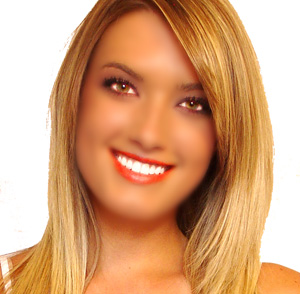 Guilty. Been there, done that. When trying out a new technique it's easy to get sucked in and begin applying it to every photo in heavier amounts. It's Kinda like the Gun's n' Roses song, "Mr. Brownstone". "I used to do a little but the little got more and more. I just keep trying to get a little better, a little better than before." Ok, now it's time for "Retouching Rehab". More and more I see photos where there is way too much skin blurring, over-done eye whitening with no regard for realism at all; and the worst of all, over-cooked HDR. It seems that someone gets a basic DSLR, a photo program and an article on how to smooth skin- and they create these Frankenstein images and start selling their services as photographers.
Guilty. Been there, done that. When trying out a new technique it's easy to get sucked in and begin applying it to every photo in heavier amounts. It's Kinda like the Gun's n' Roses song, "Mr. Brownstone". "I used to do a little but the little got more and more. I just keep trying to get a little better, a little better than before." Ok, now it's time for "Retouching Rehab". More and more I see photos where there is way too much skin blurring, over-done eye whitening with no regard for realism at all; and the worst of all, over-cooked HDR. It seems that someone gets a basic DSLR, a photo program and an article on how to smooth skin- and they create these Frankenstein images and start selling their services as photographers.
Now, it's understood that photography is an art form, and not everyone sees things the same way; but I'm only addressing the collective opinions that many of us share regarding techniques that are over-used. Take wedding photography for example. I don't do weddings, but in my opinion good wedding photos should be about the composition- the moment in time for that family's biggest day, and the bride whom has waited her whole life for it. What I see out there all the time are boring photos that look like anyone standing around could have taken, but with the bride's face put through a blender of blur-filters and masking. I feel that good image design is about a good capture first, and then the post-production is used to either fix problems or enhance the feel or mood of the image. It's ok to remove some power lines in the background, or desaturate the image to convey a certain feel, just be careful not to forget about the photography part.
I wouldn't include things like digital art or compositing as retouching. I do a lot of composite work as part of my art and services, so many hours are spent creating images that were otherwise impossible to happen. It's just a creative thing. However, in advertising we retouch "impossibly good" model's skin and facial or body features. This is done on purpose, because in the advertising world there is a different psychology that makes people want to buy products and services where models are used. We make it look so real though, that there should never be anything that can be pointed out by the general public as fake or retouched. However, I don't necessarily think this level of retouching should be used in portraits, since it's too easy to get trapped into over-doing it. Plus, most non-professional models would very likely have their feelings hurt when they see their portrait come back looking like a cartoon character version of themselves. They will think to themselves; "Do I really look that bad for all that Photoshop?". Be mindful of defeating the purpose of retouching.
If retouching portraits is your thing, just try to "keep it real". For instance, if you are shooting for a commercial advertisement, or even just for your own portfolio, avoid using a model with really bad skin in the first place. Someone who has clear skin, but with just a few blemishes is much easier to make look good than someone who's face is going to have to be replaced. Unless you like sitting in front of the screen for hours retouching, this is one of the easiest ways to avoid having an image come out "overdone". The point of a good photo is that is does not look 'over-Photoshopped'.
Take a break. Too often we get into a "must have it finished now" thing, and the more you look at the photo, the more "fixing" it needs. If you just go to bed and look at it the next day, you might see that it didn't need anymore retouching. This depends of course, but too many times I've finished a photo only to look at it the next day and realized that I grinded it to a pulp in post production, thinking that it needed more retouching.
The worst I've seen is the HDR stuff. It's like a virus that gets in to every photographer who uses it and they have to keep turning up that effect more and more. It's great if that's the "art" that they want to create, but just realize, everybody else can -and are- doing it. Hitting the "Auto Destroy" button on every photo isn't necessarily a unique art. I love HDR when it's done to make an image look like it did when it was taken (since cameras aren't nearly as sophisticated as the human eye), but that's just my opinion on what I like, even though I've never used it (yet).
So the next time you pick up that mouse or tablet pen to get to some serious retouching, try to think about whether or not you are helping the image, or trashing it. The pro's know the difference, why not you?
My interview with Jason Anderson of CannonBlogger.com!
Last week I had the pleasure of being asked to do an interview with photographer Jason Anderson on his increasingly popular blog site, CannonBlogger.com . The focus of the interview was mainly on the business side of commercial photography, with a few bits and pieces about my equipment list and lighting preferences. We both had fun doing the interview and it went really smoothly (especially since sometimes I have a tendency to ramble). In addition to being an avid blogger, Jason is also a very creative landscape photographer. You can check out his portfolio and blog at www.canonblogger.com. The interview is available via podcast and also online (the title is, "Holy Hybrids- It's High Fashion!") at http://itunes.apple.com/WebObjects/MZStore.woa/wa/viewPodcast?id=271139084. Thank you Jason for an interview that was more like a couple of blokes just sitting at a bar!
Behind the Scenes- Albuquerque High Fashion
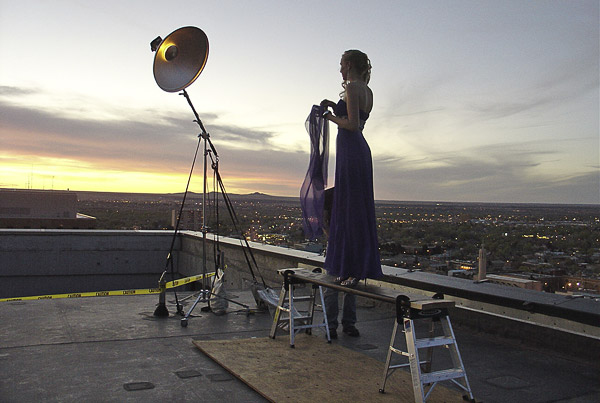 Shooting fashion editorials can be a lot of fun, and they can also be a lot of work. Getting eight people, 700 lbs of equipment and several thousand dollars of wardrobe and jewelry on top of four downtown skyscrapers is a heavy task- literally. The elevators went to the top only on one building, and the other three- well, my assistants and I carried every piece of gear up many flights of stairs.
Shooting fashion editorials can be a lot of fun, and they can also be a lot of work. Getting eight people, 700 lbs of equipment and several thousand dollars of wardrobe and jewelry on top of four downtown skyscrapers is a heavy task- literally. The elevators went to the top only on one building, and the other three- well, my assistants and I carried every piece of gear up many flights of stairs.
Once on top, we set up scaffolding rigs so that the models would appear on the edges of the buildings once the shots were lined up. In the above sequence, we literally had to have Kevin, my 2nd assistant stand just off-frame to keep our model,Lauren from getting near the edge in case she stumbled off the scaffold rig in high heels.
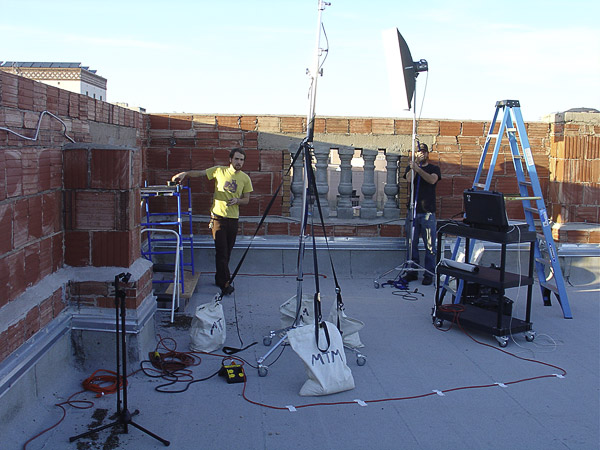
Shooting for magazines requires a well-planned idea of how each shot is going to be composed. If a shot is going to be a vertical full-page shot, a double-truck horizontal, a half page or a cover affects how each sequence is going to be set up and lit. In this sequence we were setting up for a shot with downtown Central avenue in the background.
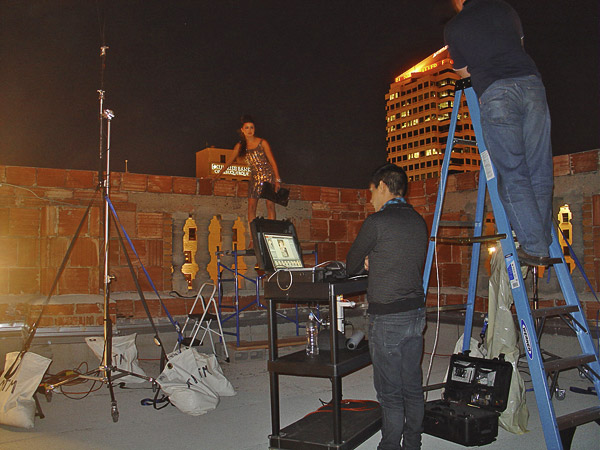
The wall around the top of the building was about ten feet high. So in order to get our model Tiffany high enough for it to look like a normal-sized wall, we had to build up a scaffold rig and make it safe for her to move around on. My assistants know all too well the potential of wind when out on location, so everything is strapped down to sandbags that weigh hundreds of pounds when linked together.
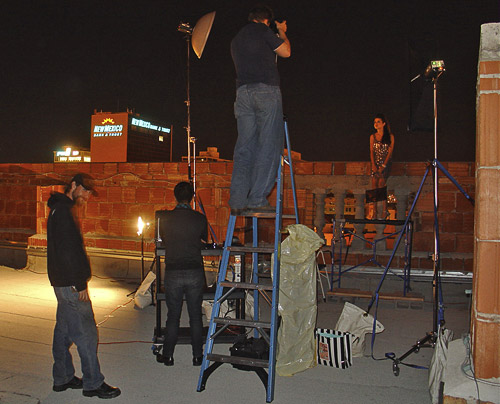
It's good that they did this, because at about 11:00 PM, the wind went from zero to 55 mph in about 10 seconds. Stuff was blowing everywhere. It absolutely came out of no where with no build up at all and lasted the rest of the shoot. I normally will use the wind to my advantage when shooting on location but this was like,"aw come on!". We ended up with some really spectacular shots, especially after the compositing was done. But it made for a rough time during the shoot, especially for the guys who had to hold down the lights since the sand bags weren't even enough.
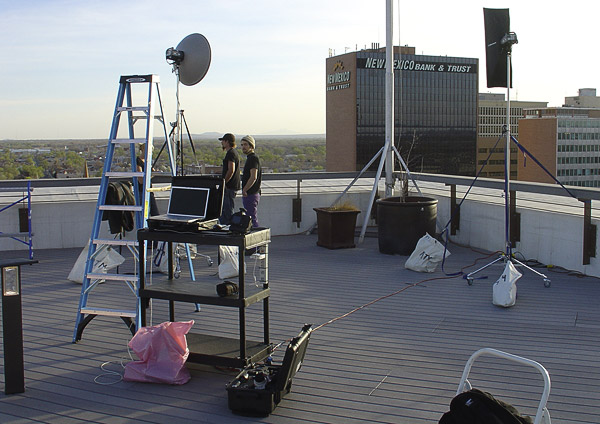
Each evening was beautiful to begin with, but later would turn into gail force winds as we shot. On the third night, we had 3 models each with their own sequence. Alexx did a great job doing 3 different hair and makeup looks that took him several hours. Once one model was done, we would take her to go shoot and he would start on the next.
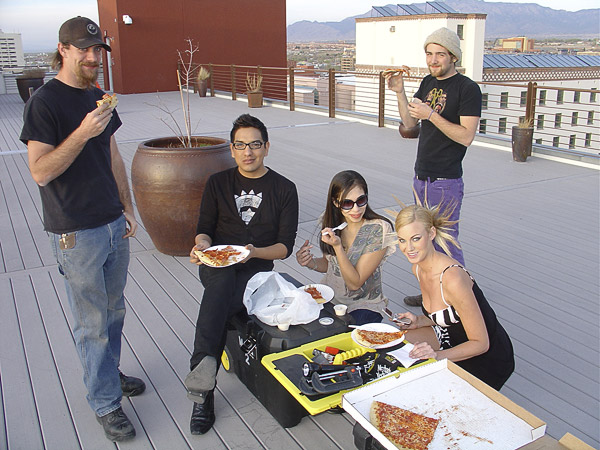
A big part of keeping your crew happy is keeping them fed. So I always make sure we have meal breaks on any shoot that lasts over 4 hours and supply the models and crew with something good to keep the mood positive.
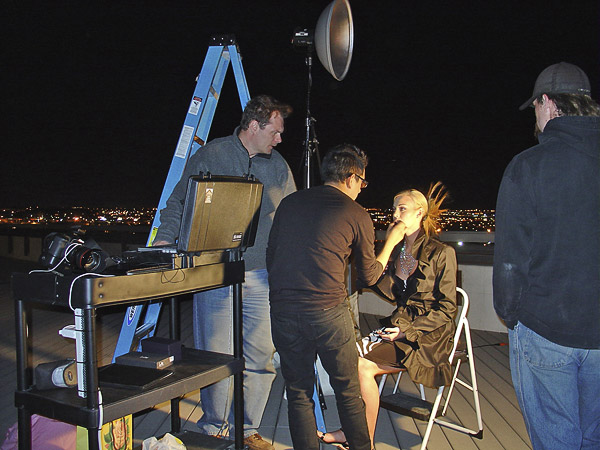
Our model, Shannon had to stand on a railing about 14 stories above the street. There was a safety thrust just off the edge of the railing that would keep her from falling (that later would be composited out), but none the less it was pretty nerve-racking being up there, especially with the wind blowing us around. I'm all for getting a great shot, but I wont compromise anyone's safety or comfort when it comes to things like this. I gotta hand it to these girls and the crew though for being so willing to do some scary stuff in order to get the shot. My hat's off to 'em.
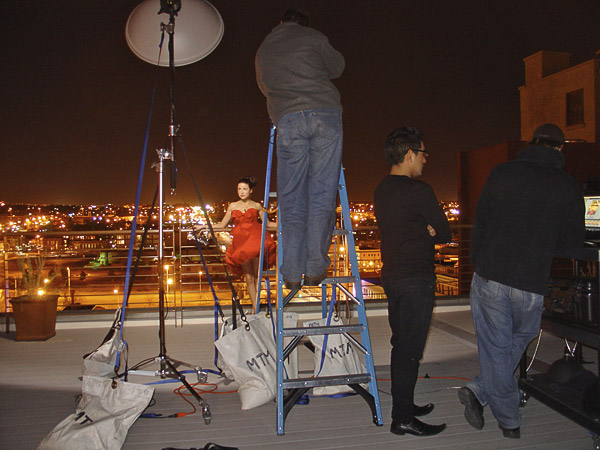
This was one of the more laborious shoots, starting at 4:00 pm and going until 3:00 am. It just takes that long to set everything up and even to do the load out. A shoot sequence might only run 30 minutes, but everything in between from frame setup, to makeup and hair to loading all the gear around just takes a toll. But when you love what you do, it's always a good time. You can view the shots from this in the Fashion/Editorial gallery in my Portfolio. We didn't get many behind the scenes shots on this one because everyone was so busy holding down everything from the wind. But thanks to Kevin and Dustin for getting a few shots. And thanks again to Lauren, Natilee, Tiffany, and Shannon, Alexx and the whole crew for doing such a tremendous job so late into each night. It was still a beautiful experience.
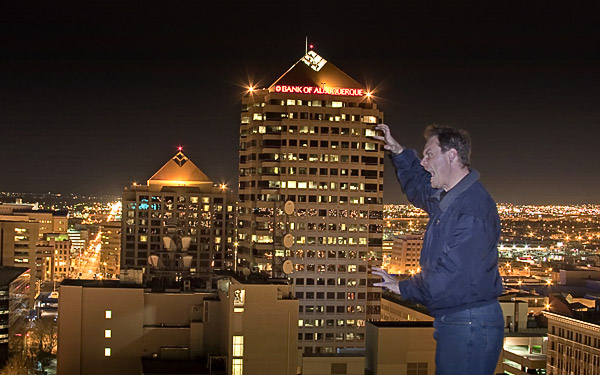
Oh yea, had to throw in this obligatory shot. ;)
Photo Contests & the Acid Trip Theory
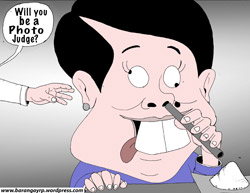
- Always shoot black and white.
- Always shoot out of focus or with slow shutter speeds to purposely make the image unintelligible.
- Make sure it's not anything beautiful.
- Most importantly, make sure the photo makes no sense at all whatsoever- just spin around in a circle and take pictures. Because if the photo has a subject, or makes any sense at all, the photo judge won't be able to "understand" it, and it will be discarded.
Welcome to my blog!
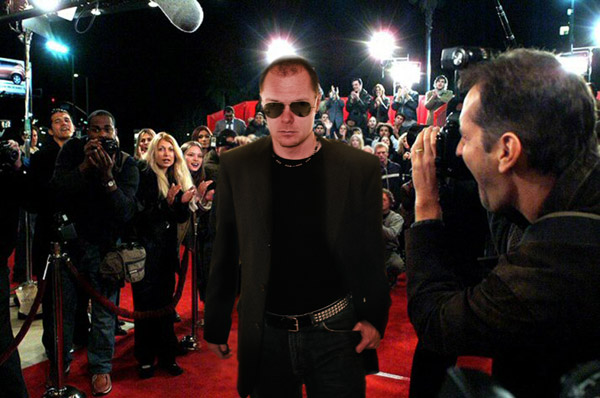 Hello, my name is Matt Timmons in case it hasn't been plastered around here enough times. I am a commercial photographer, specializing in beauty and fashion advertising. I'm not a typical 'weird' photographer type, a camera is not my soul, it's just a tool I use. I'm also an avid sportbike rider/racer, an ex-commercial jet pilot, and a very part-time film and TV actor. That's a picture of me above as usual being chased by the paparazzi at a premier, and is in no way a bad composite of me Photoshopped in (cough).
This is my personal blog where I like to post up the overflow stuff that there isn't room for on the main site. From time to time I like to put up articles, behind-the-scenes photos of recent shoots, travel shots and just anything that I think might be of interest. I don't try to be too serious, so keep that in mind as I like to poke fun at stuff a lot. And I use parentheses a lot also (a lot).
So sit back, crack open a cold one, and make yourself at home for some stuff that really matters, and more stuff that you thought you knew but didn't. It's all good here- smily face emoticons for everyone. :)
Hello, my name is Matt Timmons in case it hasn't been plastered around here enough times. I am a commercial photographer, specializing in beauty and fashion advertising. I'm not a typical 'weird' photographer type, a camera is not my soul, it's just a tool I use. I'm also an avid sportbike rider/racer, an ex-commercial jet pilot, and a very part-time film and TV actor. That's a picture of me above as usual being chased by the paparazzi at a premier, and is in no way a bad composite of me Photoshopped in (cough).
This is my personal blog where I like to post up the overflow stuff that there isn't room for on the main site. From time to time I like to put up articles, behind-the-scenes photos of recent shoots, travel shots and just anything that I think might be of interest. I don't try to be too serious, so keep that in mind as I like to poke fun at stuff a lot. And I use parentheses a lot also (a lot).
So sit back, crack open a cold one, and make yourself at home for some stuff that really matters, and more stuff that you thought you knew but didn't. It's all good here- smily face emoticons for everyone. :)
